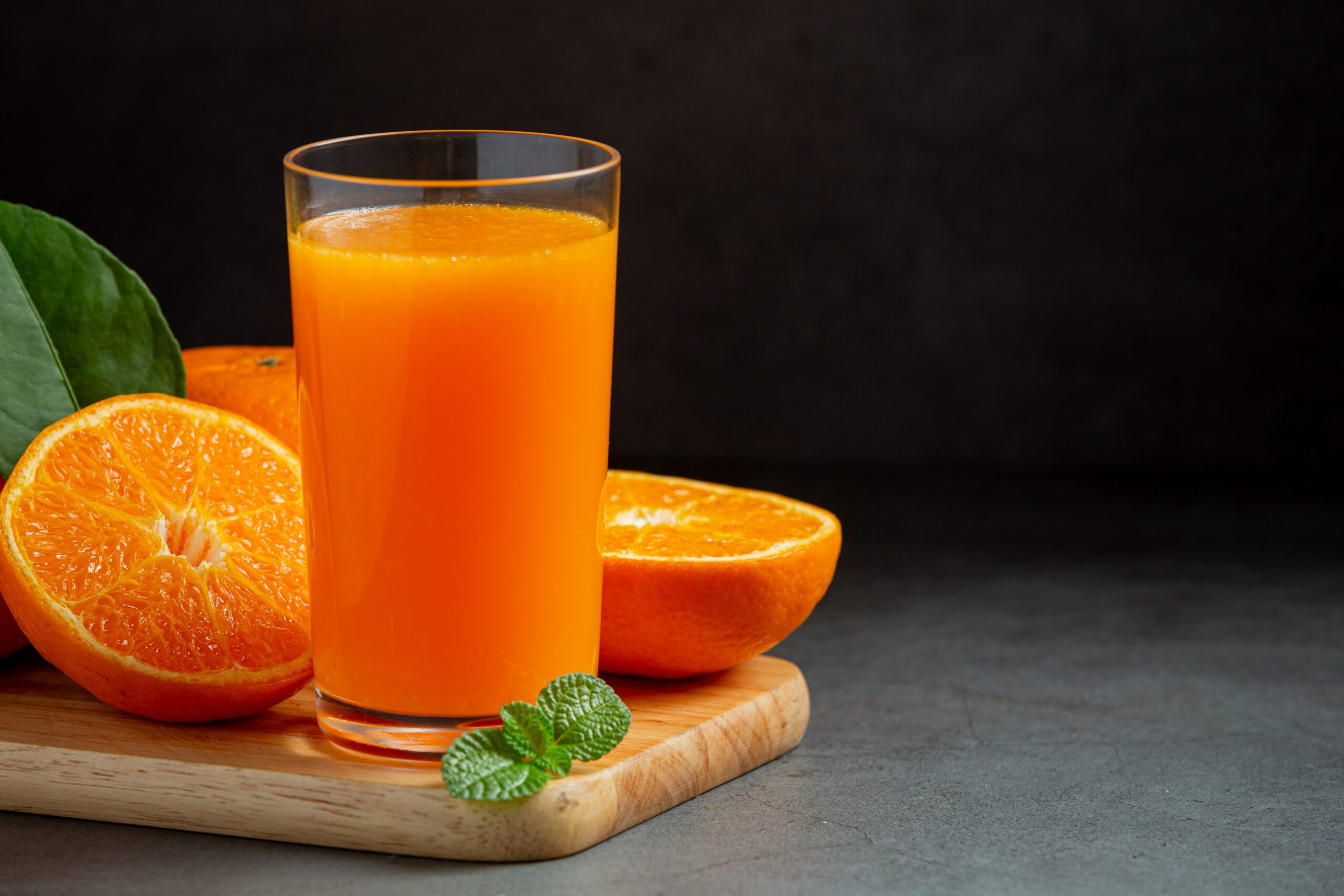Is Fruit Juice Good for Weight Loss?
Fruit juice, while packed with essential vitamins and minerals, is not always the best option for weight loss. Here’s an in-depth analysis:
Nutritional Profile of Fruit Juice
- High in Sugars:
- Even though the sugars in fruit juice are natural, they can still contribute to a high calorie intake. For example, a glass of orange juice can contain about 20 grams of sugar and 85-120 calories.
- Lack of Fiber:
- The juicing process often removes the fiber present in whole fruits. Fiber is crucial for weight loss because it aids digestion, promotes satiety, and helps regulate blood sugar levels.
- Caloric Density:
- Fruit juice is less filling compared to whole fruits, leading to the consumption of additional calories without the same sense of fullness.
- Nutrient Loss:
- Some vitamins, like vitamin C, can degrade quickly after juicing, reducing the nutritional value of the juice over time.
How Fruit Juice Can Affect Weight Loss
- Insulin Spikes:
- The high sugar content can cause rapid spikes in blood sugar and insulin levels, which may promote fat storage and increase hunger soon after consumption.
- Overconsumption:
- It’s easy to consume a large amount of calories from juice without realizing it. For instance, it takes multiple oranges to make one glass of orange juice, resulting in higher calorie consumption than eating one or two whole oranges.
- Liquid Calories:
- Calories from liquids/ fruit juice are generally not as satisfying as those from solid foods, leading to higher overall calorie intake throughout the day.
Healthier Alternatives for Weight Loss
To better support weight loss, consider these alternatives that provide essential nutrients without the drawbacks of fruit juice.
1. Whole Fruits
Benefits:
- High Fiber Content: Whole fruits retain their fiber, which helps you feel full longer and aids in digestion.
- Low Energy Density: Fruits are generally low in calories but high in water and fiber, which can help control hunger.
Examples: Apples, berries, oranges, and pears.
2. Vegetable Juices
Benefits:
- Low in Sugar: Vegetables like spinach, kale, and celery are lower in sugar compared to fruits.
- Nutrient-Dense: They provide essential vitamins and minerals with fewer calories.
Examples: Green juice made from kale, cucumber, celery, and a small apple for sweetness.
3. Smoothies
Benefits:
- Fiber Retention: Unlike juices, smoothies retain the fiber of the whole fruit.
- Satiety: Adding ingredients like Greek yogurt, chia seeds, or protein powder can make smoothies more filling.
Recipe: A smoothie with spinach, banana, Greek yogurt, chia seeds, and a small amount of almond milk.
Whole Food, Plant-Based (WFPB) Diet: A Comprehensive Guide
The Whole Food, Plant-Based (WFPB) diet emphasizes consuming unprocessed or minimally processed plant foods. This diet is rich in nutrients, promotes health, and supports sustainable weight loss. Here’s an in-depth look at what it involves, its benefits, and how to implement it effectively.
Key Principles of the WFPB Diet
- Whole Foods:
- Consume fruits in their natural state, with minimal or no processing. This includes fresh fruits and seasonal fruits Plant-Based:
- Avoid animal products such as meat, dairy, eggs, and fish. The emphasis is on foods derived from plants.
- Minimally Processed:
- Avoid refined foods like white flour, white sugar, and oil. Choose foods that are in natural form as possible. Eat natural foods
- No Added Sugars and Oils:
- Minimize or eliminate added sugars and oils to reduce calorie intake and improve heart health.
Benefits of the WFPB Diet
1. Weight Loss
Caloric Density:
- Whole plant foods are generally low in calories and high in fiber and water, which helps you feel full and satisfied without overeating.
Satiety:
- High fiber content in plant-based foods slows digestion and keeps you feeling fuller for longer, reducing overall calorie intake.
2. Improved Heart Health
Cholesterol Reduction:
- Eliminating animal products can significantly reduce LDL (bad) cholesterol levels, lowering the risk of heart disease.
Blood Pressure:
- The high potassium content in fruits and vegetables helps regulate blood pressure.
3. Better Blood Sugar Control
Fiber:
- High fiber intake from whole grains, fruits, and vegetables helps stabilize blood sugar levels, making it beneficial for those with diabetes or insulin resistance.
Low Glycemic Index:
- Many plant-based foods have a low glycemic index, preventing spikes in blood sugar.
4. Enhanced Digestion
Digestive Health:
- The fiber in plant-based foods promotes healthy bowel movements, preventing constipation and supporting gut health.
Gut Microbiome:
- A diet rich in diverse plant foods promotes a healthy gut microbiome, which is essential for overall health.
How to Implement the WFPB Diet
1. Breakfast Options
Oatmeal:
- Top with fresh fruits, nuts, and seeds.
- Example: A bowl of steel-cut oats with blueberries, flaxseeds, and a drizzle of maple syrup.
Smoothies:
- Blend a variety of fruits, vegetables, and plant-based milk.
- Example: Spinach, banana, and almond milk smoothie with chia seeds.
2. Lunch Ideas
- A variety of leafy greens with colorful vegetables, beans, and a light dressing made from avocado or tahini.
- Example: Kale salad with chickpeas, cherry tomatoes, cucumbers, and lemon-tahini dressing.
Grain Bowls:
- Whole grains like quinoa or brown rice with vegetables and legumes.
- Example: Quinoa bowl with black beans, corn, bell peppers, and avocado.
3. Dinner Suggestions
Stir-Fries:
- A mix of vegetables and tofu or tempeh, stir-fried with tamari sauce and served over brown rice.
- Example: Broccoli, bell peppers, and tofu stir-fry with sesame seeds.
Hearty Soups:
- Vegetable and legume-based soups.
- Example: Lentil soup with carrots, celery, tomatoes, and spinach.
4. Snacks
Fresh Fruit:
- Apples, oranges, berries, and bananas.
Nuts and Seeds:
- Almonds, walnuts, chia seeds, and sunflower seeds.
Vegetable Sticks:
- Carrot and celery sticks with hummus.
Practical Tips for Success
1. Meal Planning and Preparation
Plan Ahead:
- Plan your meals and snacks for the week to ensure you have all the necessary ingredients and avoid unhealthy choices.
Batch Cooking:
- Prepare large quantities of grains, beans, and vegetables that can be used in multiple meals throughout the week.
2. Reading Labels
Check Ingredients:
- Avoid products with added sugars, oils, and artificial ingredients. Look for foods with short ingredient lists consisting of whole foods.
Nutrient Density:
- Choose foods that provide a high nutrient content relative to their calorie content.
3. Dining Out
Research Restaurants:
- Look for restaurants with plant-based options. Many places now offer vegan or vegetarian menus.
Customize Orders:
- Don’t hesitate to ask for modifications to make meals more WFPB-friendly, such as requesting extra vegetables or swapping animal products for plant-based alternatives.
Conclusion
While fruit juice can provide essential vitamins and minerals, its high sugar content and lack of fiber make it less suitable for weight loss. Instead of fruit juice opt for whole fruits, vegetable juices, or smoothies that retain the fiber and nutrients. A whole food, plant-based diet is a sustainable and effective strategy for weight loss, promoting overall health and well-being. By incorporating more whole, minimally processed plant foods into your diet, you can achieve and maintain a healthy weight more effectively.

